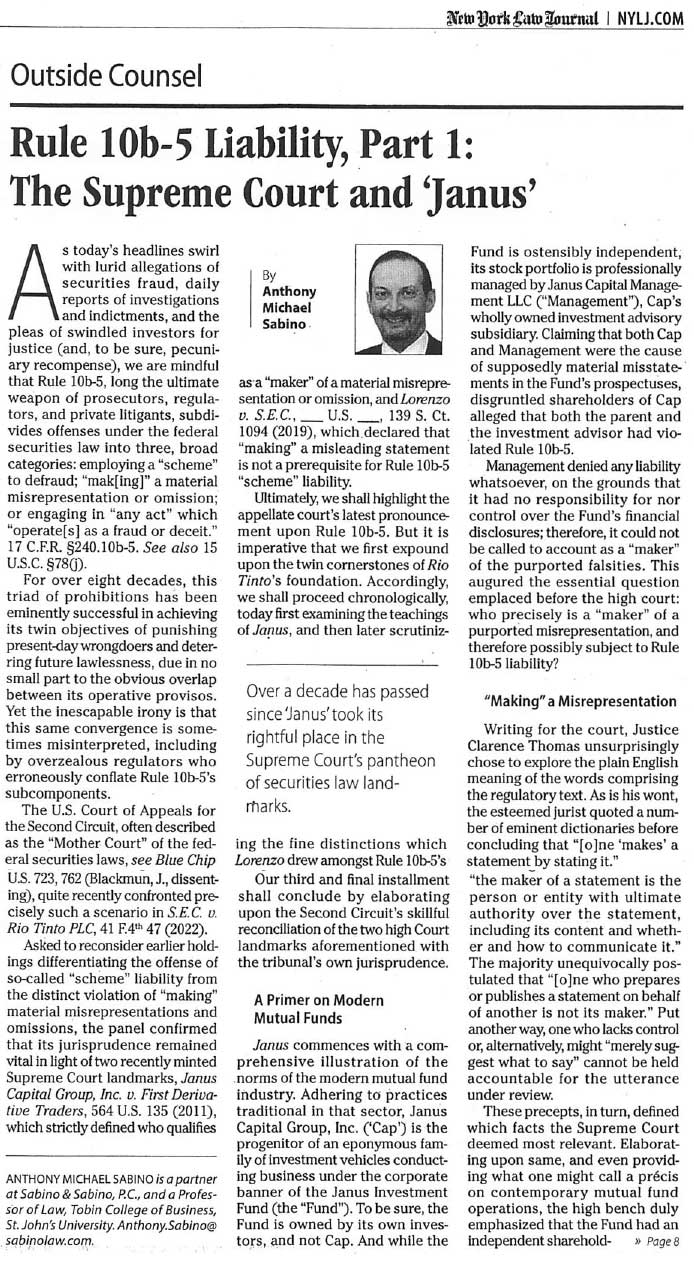
shareholder constituency, that there was no dispute that corporate formalities had been consistently observed, and that Management and the Fund inarguably stood as separate legal entities.
Finally, and in a most telling point, Janus notes that only one member of the Fund’s board of trustees was associated with Management, verifying that the former enjoyed a degree of independence well beyond the statutory minimum required for mutual fund overseers. See 15 U.S.C. §80a-10 (permitting up to 60% of a mutual fund’s board to be composed of “interested persons”).
Against this backdrop of legal maxims and essential facts, Justice Thomas then exemplified the distinction between the drafter of a speech and its actual speaker, adding the pithy observation that “content is entirely within the control of the person who delivers” the address.
In the controversy at hand, Management was far more akin to a speechwriter than a speechmaker, and, even if the investment advisor had assisted the Fund in crafting the subject prospectuses, it could not be held liable under the relevant subsection of Rule 10b-5, for reason that Management “itself did not ‘make’ those statements.”
In a forceful parenthetical, the majority declared, moreover, that it is drawing “a clean line” between “the maker…with ultimate authority…and others [who] are not.”
Harmonizing with the Private Right of Action
Notwithstanding, Janus presented additional questions in need of resolution. For one, was the high bench’s strict delineation of “make” harmonious with certain other restraints applicable to the federal securities laws? Unequivocally yes, opined Justice Thomas.
In order to explain, the learned jurist was first obligated to remind that neither Section 10 nor Rule 10b-5 expressly authorizes private litigation. See Superintendent of Insurance of N.Y. v. Bankers Life & Casualty Co., 404 U.S. 6 (1971). To be sure, the regulation’s private cause of action is purely a judicial construct, initially inferred nearly 80 years ago by the lower courts, and then belatedly sanctioned by the Supreme Court. See Blue Chip Stamps, infra, 421 U.S. at 737 (1975) (Rehnquist, J.) (the rule’s implied private right of action is “a judicial oak which has grown from little more than a legislative acorn”).
For these reasons, the subsection of the rule holding those who “make” misstatements must be cabined within strict boundaries. To do otherwise would violate the longstanding principle that judge-made remedies are not to be expanded, but, instead, confined by narrow readings. See Stoneridge Investment Partners, LLC v. Scientific-Atlanta, Inc., 552 U.S. 148 (2008). See also Santa Fe Industries, Inc. v. Green, 430 U.S. 462, 479 (1977) (“Absent a clear indication of congressional intent, we are reluctant” to expand Rule 10b-5’s implied private right of action.).
In addition, the Supreme Court had to square today’s holding with its oft-repeated pronouncement that there is no private cause of action for aiding and abetting a primary violation of Rule 10b-5. See Central Bank of Denver, N.A. v. First Interstate Bank of Denver, N.A., 511 U.S. 164 (1994). Justice Thomas voiced grave concern that a “broader reading of ‘make’” herein would convert the long-excluded subset of aiders and abettors into front-line wrongdoers, and thereby “substantially undermine Central Bank.”
By declining to impose “maker” liability upon those who lack the final say over a purported misrepresentation, the high bench avoided contradicting one of its most adamantine landmarks. And to complete this reconciliation, Thomas opined that Central Bank and its progeny “suggest[ ] the rule we adopt today: that the maker of a statement is the entity with authority over the content of the statement and whether and how to communicate it.”
Janus thereby concluded upon that clear articulation of its guiding precept: one “makes” a misrepresentation in violation of the pertinent subcomponent of Rule 10b-5 by exercising ultimate control over the misleading statement. Remaining steadfast to the quotidian meaning of “make,” the high court placed all others outside the purview of that discrete subsection—although not necessarily beyond the other proscriptions found within the body of the anti-fraud regulation.
Over a decade has passed since Janus took its rightful place in the Supreme Court’s pantheon of securities law landmarks. Over that span of years, and, furthermore, as the relevant case law has matured, we can better appreciate Justice Thomas’ forthrightness, and the supple manner in which the majority staked out an exacting border dividing those who merely play a role in the creation of specious declarations from the miscreants who enjoy the last word over deceptive utterances. Janus thereby assures that Rule 10b-5 is justly applied, in accord with its own text, and that of its enabling proviso, Section 10.
Yet, we must remember that, for all of its clarity and prodigious reasoning, Janus is delimited to the wrong of “making” misrepresentations or omissions. As for Rule 10b-5’s other prohibitions, specifically “scheming” to defraud, our next installment shall analyze the Supreme Court’s most recent wisdom in that regard.
Anthony Michael Sabino is a partner at Sabino & Sabino, P.C., and a Professor of Law, Tobin College of Business, St. John’s University. [email protected].
